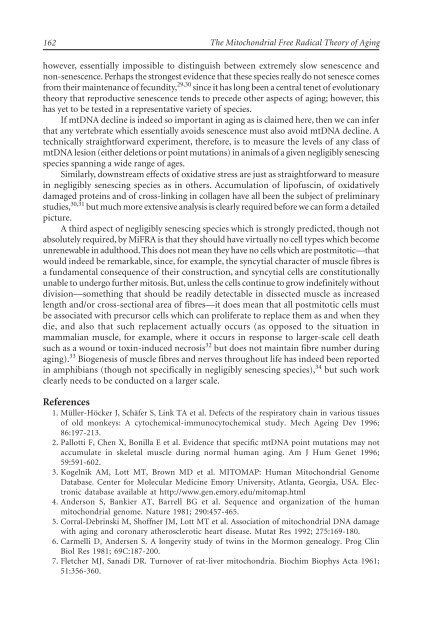The Mitochondrial Free Radical Theory of Aging - Supernova: Pliki
The Mitochondrial Free Radical Theory of Aging - Supernova: Pliki
The Mitochondrial Free Radical Theory of Aging - Supernova: Pliki
You also want an ePaper? Increase the reach of your titles
YUMPU automatically turns print PDFs into web optimized ePapers that Google loves.
162<br />
<strong>The</strong> <strong>Mitochondrial</strong> <strong>Free</strong> <strong>Radical</strong> <strong>The</strong>ory <strong>of</strong> <strong>Aging</strong><br />
however, essentially impossible to distinguish between extremely slow senescence and<br />
non-senescence. Perhaps the strongest evidence that these species really do not senesce comes<br />
from their maintenance <strong>of</strong> fecundity, 29,30 since it has long been a central tenet <strong>of</strong> evolutionary<br />
theory that reproductive senescence tends to precede other aspects <strong>of</strong> aging; however, this<br />
has yet to be tested in a representative variety <strong>of</strong> species.<br />
If mtDNA decline is indeed so important in aging as is claimed here, then we can infer<br />
that any vertebrate which essentially avoids senescence must also avoid mtDNA decline. A<br />
technically straightforward experiment, therefore, is to measure the levels <strong>of</strong> any class <strong>of</strong><br />
mtDNA lesion (either deletions or point mutations) in animals <strong>of</strong> a given negligibly senescing<br />
species spanning a wide range <strong>of</strong> ages.<br />
Similarly, downstream effects <strong>of</strong> oxidative stress are just as straightforward to measure<br />
in negligibly senescing species as in others. Accumulation <strong>of</strong> lip<strong>of</strong>uscin, <strong>of</strong> oxidatively<br />
damaged proteins and <strong>of</strong> cross-linking in collagen have all been the subject <strong>of</strong> preliminary<br />
studies, 30,31 but much more extensive analysis is clearly required before we can form a detailed<br />
picture.<br />
A third aspect <strong>of</strong> negligibly senescing species which is strongly predicted, though not<br />
absolutely required, by MiFRA is that they should have virtually no cell types which become<br />
unrenewable in adulthood. This does not mean they have no cells which are postmitotic—that<br />
would indeed be remarkable, since, for example, the syncytial character <strong>of</strong> muscle fibres is<br />
a fundamental consequence <strong>of</strong> their construction, and syncytial cells are constitutionally<br />
unable to undergo further mitosis. But, unless the cells continue to grow indefinitely without<br />
division—something that should be readily detectable in dissected muscle as increased<br />
length and/or cross-sectional area <strong>of</strong> fibres—it does mean that all postmitotic cells must<br />
be associated with precursor cells which can proliferate to replace them as and when they<br />
die, and also that such replacement actually occurs (as opposed to the situation in<br />
mammalian muscle, for example, where it occurs in response to larger-scale cell death<br />
such as a wound or toxin-induced necrosis 32 but does not maintain fibre number during<br />
aging). 33 Biogenesis <strong>of</strong> muscle fibres and nerves throughout life has indeed been reported<br />
in amphibians (though not specifically in negligibly senescing species), 34 but such work<br />
clearly needs to be conducted on a larger scale.<br />
References<br />
1. Müller-Höcker J, Schäfer S, Link TA et al. Defects <strong>of</strong> the respiratory chain in various tissues<br />
<strong>of</strong> old monkeys: A cytochemical-immunocytochemical study. Mech Ageing Dev 1996;<br />
86:197-213.<br />
2. Pallotti F, Chen X, Bonilla E et al. Evidence that specific mtDNA point mutations may not<br />
accumulate in skeletal muscle during normal human aging. Am J Hum Genet 1996;<br />
59:591-602.<br />
3. Kogelnik AM, Lott MT, Brown MD et al. MITOMAP: Human <strong>Mitochondrial</strong> Genome<br />
Database. Center for Molecular Medicine Emory University, Atlanta, Georgia, USA. Electronic<br />
database available at http://www.gen.emory.edu/mitomap.html<br />
4. Anderson S, Bankier AT, Barrell BG et al. Sequence and organization <strong>of</strong> the human<br />
mitochondrial genome. Nature 1981; 290:457-465.<br />
5. Corral-Debrinski M, Sh<strong>of</strong>fner JM, Lott MT et al. Association <strong>of</strong> mitochondrial DNA damage<br />
with aging and coronary atherosclerotic heart disease. Mutat Res 1992; 275:169-180.<br />
6. Carmelli D, Andersen S. A longevity study <strong>of</strong> twins in the Mormon genealogy. Prog Clin<br />
Biol Res 1981; 69C:187-200.<br />
7. Fletcher MJ, Sanadi DR. Turnover <strong>of</strong> rat-liver mitochondria. Biochim Biophys Acta 1961;<br />
51:356-360.


